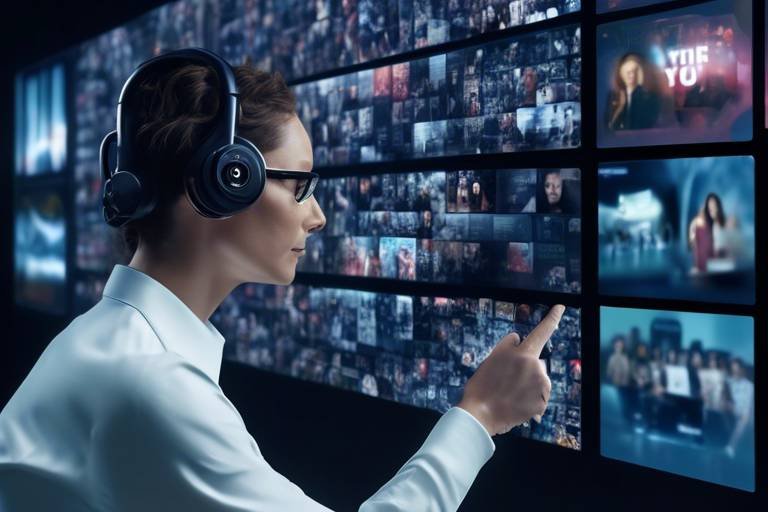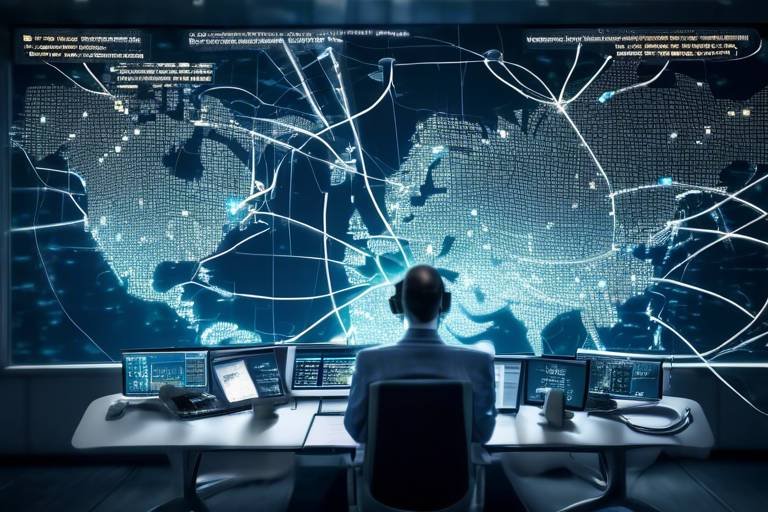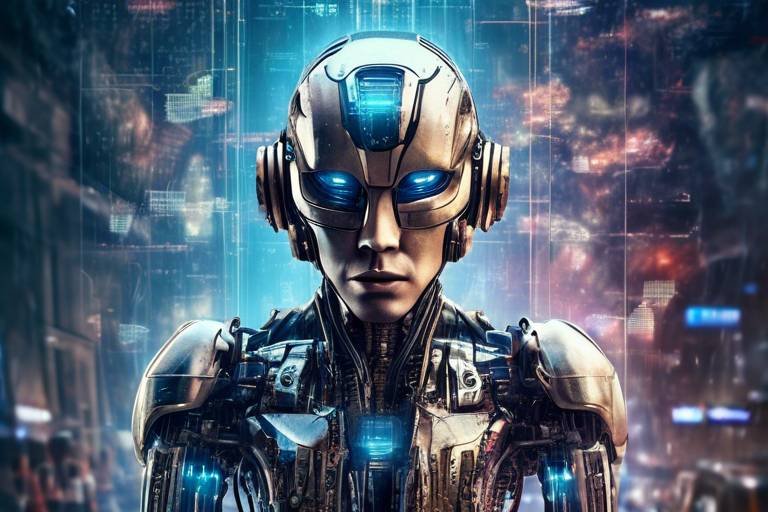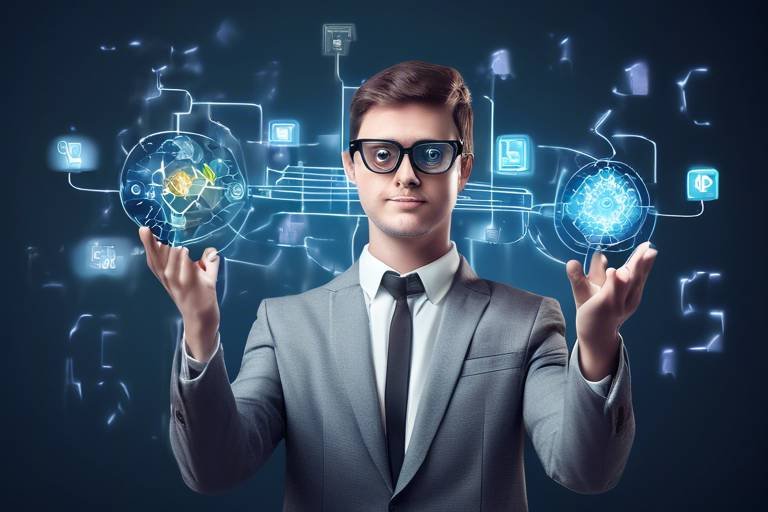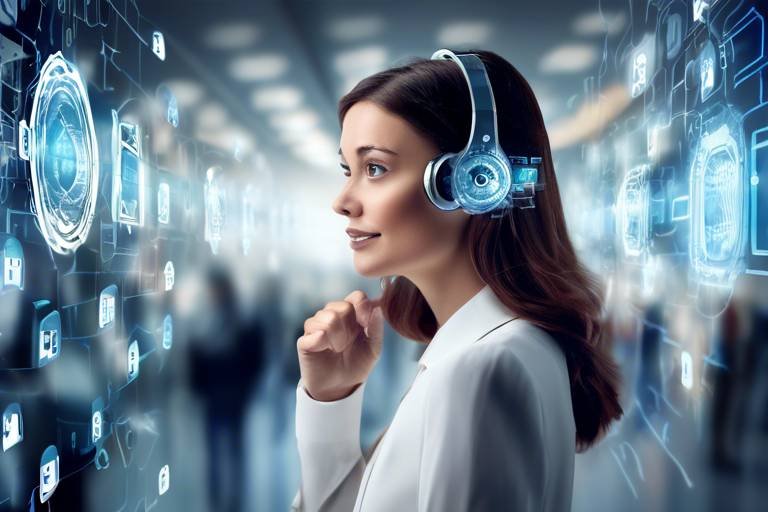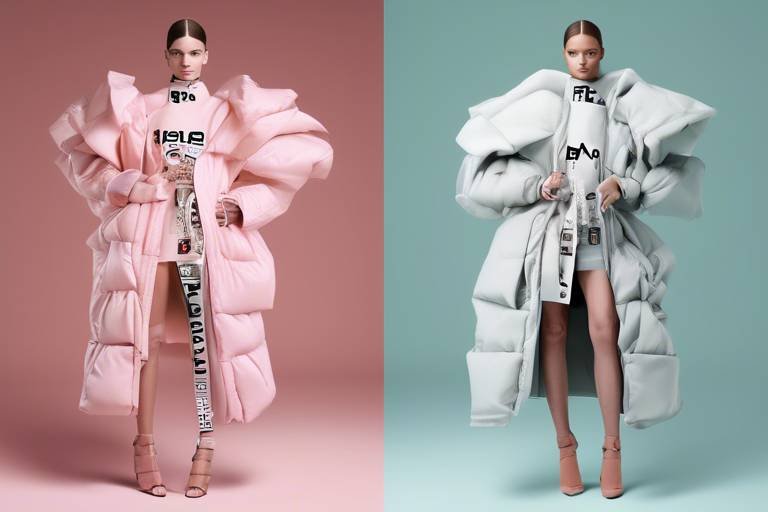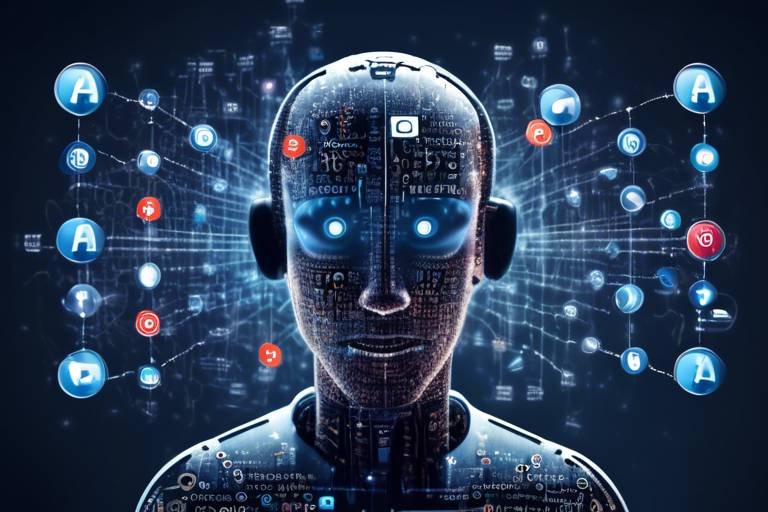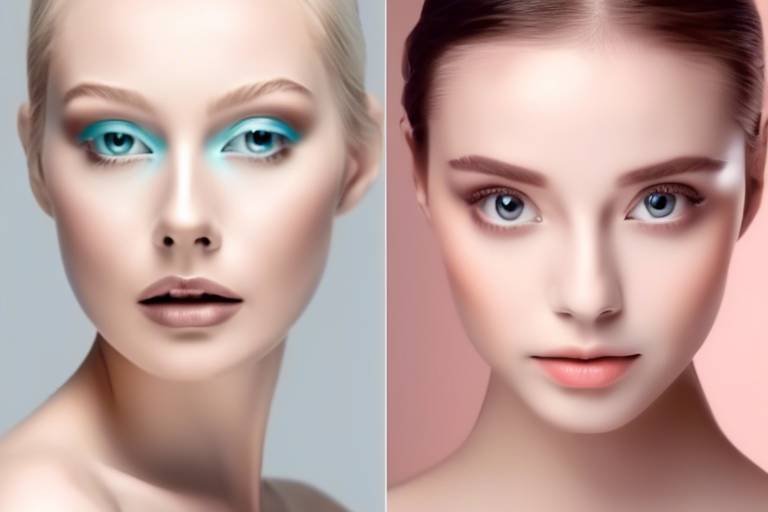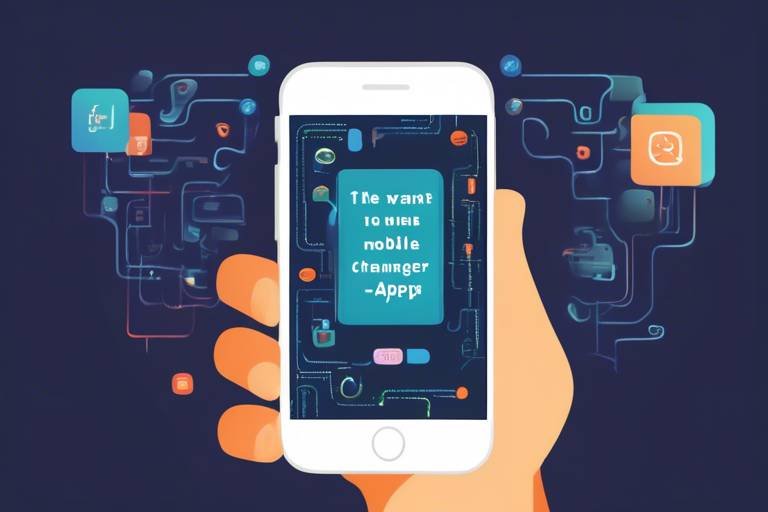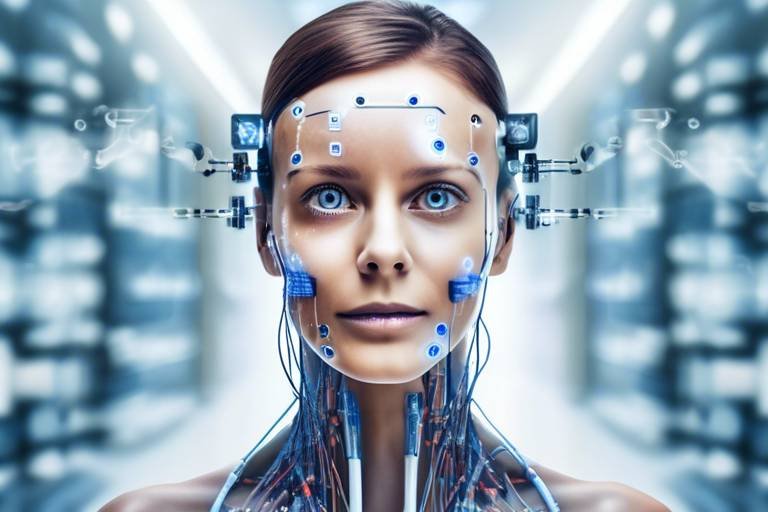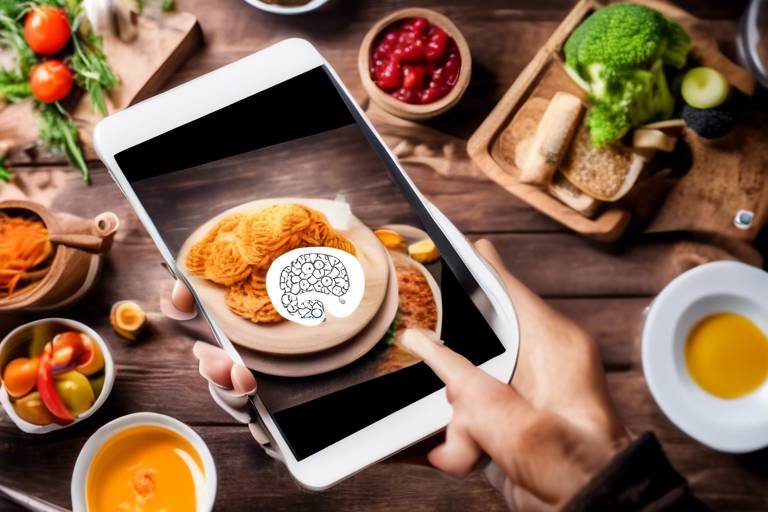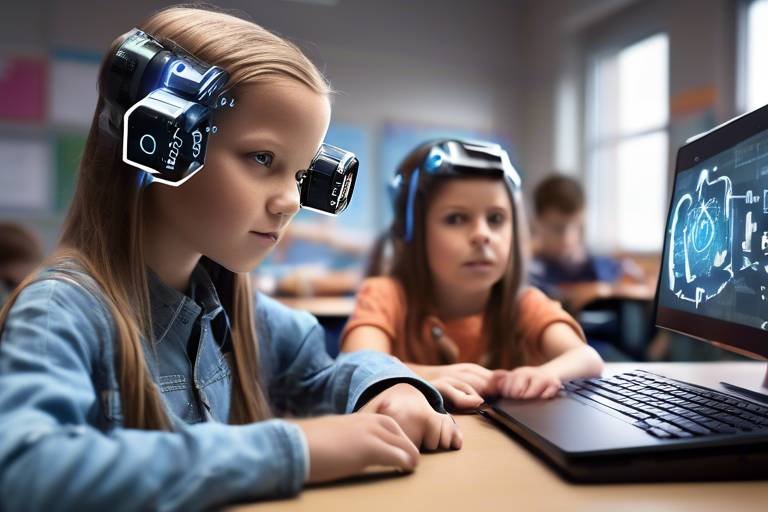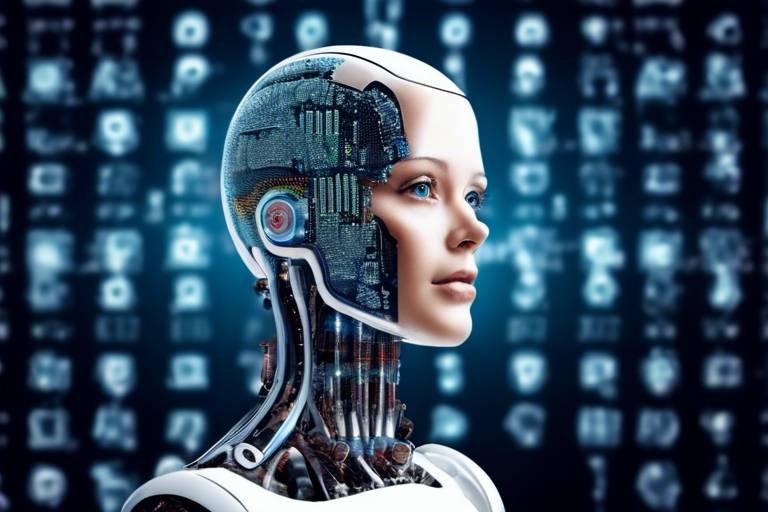The Intersection of Aesthetics and AI
In a world where technology and creativity are increasingly intertwined, the intersection of aesthetics and artificial intelligence (AI) is nothing short of revolutionary. Imagine stepping into a gallery filled with artwork that not only captivates the eye but also challenges your perception of what art truly is. This is the new reality, where AI is not just a tool but a collaborator in the creative process. As we delve into this fascinating realm, we'll explore how AI is reshaping the landscape of art and design, pushing the boundaries of human expression while simultaneously raising questions about authenticity and originality.
Art has always been a reflection of the times, and now, with the advent of AI, it’s evolving at an unprecedented pace. Artists are harnessing the power of AI to explore new techniques, mediums, and concepts, allowing for a deeper exploration of creativity. Think of AI as a new brush in an artist's toolkit—one that can analyze vast amounts of data, identify trends, and even suggest innovative ideas that a human might not have considered. This collaboration between human intuition and machine learning is not just enhancing the creative process; it’s redefining it.
However, this integration of AI into the creative sphere isn’t without its challenges. Questions about the essence of creativity arise: Can a machine truly create art? What does it mean for something to be original if it has been generated by an algorithm? As we navigate these complex issues, it becomes clear that the dialogue surrounding AI and aesthetics is just as important as the art itself. We are at a crossroads where technology meets tradition, and the outcome may very well shape the future of artistic expression.
As we venture further into this exploration, we will examine the various ways AI is influencing art creation, design innovations, and the ethical considerations that come with it. From generative art that blurs the lines between human creativity and machine output to personalized aesthetic experiences that cater to individual tastes, the intersection of aesthetics and AI is a dynamic landscape that invites curiosity and discussion. Join us as we unravel this captivating narrative that is reshaping the way we perceive and engage with art.
AI tools are transforming traditional art-making by enabling artists to explore new techniques and mediums, thus expanding the boundaries of creativity and expression in the digital age.
From architecture to graphic design, AI is revolutionizing design practices by providing innovative solutions that enhance functionality and aesthetics, leading to more efficient and visually appealing outcomes.
Generative art utilizes algorithms to create unique pieces, blurring the lines between human creativity and machine-generated content, raising intriguing questions about authorship and artistic intent.
Collaborative art projects showcase the synergy between human intuition and AI's analytical capabilities, resulting in groundbreaking works that challenge traditional notions of creativity.
Machine learning models analyze vast datasets to identify patterns and trends, influencing aesthetic choices and enabling artists to create works that resonate with contemporary audiences.
As AI-generated art gains popularity, ethical considerations surrounding originality, plagiarism, and the value of human creativity become increasingly significant in discussions about the future of art.
The integration of AI in aesthetic experiences, from virtual reality to interactive installations, is redefining how audiences engage with art and design, creating immersive environments that enhance emotional connections.
AI technologies enable personalized aesthetic experiences by analyzing user preferences, leading to tailored content that resonates on an individual level, transforming how we interact with art and design.
The fashion and beauty industries are leveraging AI to predict trends, enhance design processes, and create personalized shopping experiences, illustrating the profound impact of technology on aesthetics.
- What is generative art? Generative art is a form of art created using algorithms, where the artist sets parameters and the AI generates unique pieces based on those rules.
- Can AI create original art? While AI can generate art, the originality of the work is often debated, as it relies on existing data and algorithms created by humans.
- How is AI used in design? AI is used in design to enhance functionality, predict trends, and create personalized experiences, making the design process more efficient and tailored to user preferences.
- What ethical concerns arise from AI-generated art? Ethical concerns include issues of originality, potential plagiarism, and the implications for human artists in a rapidly evolving creative landscape.

The Role of AI in Art Creation
In today’s digital age, the realm of art is undergoing a remarkable transformation, largely fueled by the advent of artificial intelligence. Artists are no longer confined to traditional methods; instead, they are embracing AI tools that allow them to push the boundaries of creativity and expression. Imagine stepping into a world where your brush strokes are guided by algorithms, where colors blend in ways you never thought possible, and where the canvas is not just a surface but a dynamic interface. This is the new frontier of art creation.
AI is revolutionizing the art-making process by providing artists with innovative tools that enhance their creative capabilities. For instance, consider the use of machine learning algorithms that analyze existing artworks to generate new concepts. These algorithms can sift through vast amounts of data, identifying patterns and trends that human artists might overlook. This not only broadens the artist's toolkit but also inspires new forms of expression that blend human intuition with machine precision.
Take, for example, the rise of AI-assisted painting applications. These programs can suggest color palettes, composition adjustments, and even style influences based on the user’s previous works or popular trends. The result? A collaborative dance between artist and machine that leads to stunning, unexpected outcomes. Artists can use these tools to create pieces that resonate with contemporary audiences, tapping into a collective visual language shaped by technology.
Moreover, AI is not just a passive tool; it actively engages in the creative process. Generative art, for instance, employs algorithms to produce unique artworks that challenge traditional notions of authorship. When a computer generates a piece based on specific parameters set by the artist, questions arise: Who is the true creator? Is it the artist who programmed the machine, or the machine itself? This blurring of lines between human creativity and machine-generated content invites a rich dialogue about the essence of art and its creation.
To illustrate the impact of AI on art creation, let’s look at some specific applications:
| Application | Description |
|---|---|
| Style Transfer | AI algorithms can take the style of one artwork and apply it to another, creating a blend of influences. |
| Interactive Installations | Artists use AI to create installations that respond to viewer interactions in real-time. |
| AI-Generated Music | Music composition can also benefit from AI, generating scores that complement visual art. |
As we delve deeper into this intersection of art and AI, it’s crucial to recognize the ethical implications that accompany these advancements. With the rise of AI-generated art, discussions surrounding originality, plagiarism, and the intrinsic value of human creativity become increasingly relevant. Are we at risk of losing the human touch in art, or is this merely a new chapter in the age-old narrative of artistic evolution?
Ultimately, the role of AI in art creation is not just about technology; it's about expanding our understanding of what art can be. It invites artists to explore new mediums and techniques, encouraging a collaborative spirit that merges human creativity with the analytical prowess of machines. As we continue to navigate this exciting landscape, one thing is clear: the future of art is not just in the hands of humans anymore; it's a shared canvas where both artists and AI can create masterpieces together.

AI-Driven Design Innovations
In today's fast-paced world, the intersection of technology and design has never been more pronounced, and at the forefront of this revolution is artificial intelligence. AI is not just a buzzword; it's a transformative force that is reshaping how we approach design across various fields. From architecture to graphic design, AI tools are providing innovative solutions that enhance both functionality and aesthetics, leading to outcomes that are not only efficient but also visually stunning.
Imagine a world where designers can harness the power of AI to create spaces that are not only beautiful but also tailored to the needs of their inhabitants. For instance, AI algorithms can analyze data from user interactions within a space to optimize layouts and improve user experience. This is not just theoretical; it’s happening now. Architects are using AI to simulate how light interacts with different materials and structures, allowing them to make informed decisions that impact both the look and feel of a building. This level of precision and customization was once the stuff of dreams, but it’s becoming a reality.
Moreover, in the realm of graphic design, AI tools are revolutionizing the creative process. Designers can now utilize AI to generate unique patterns, color palettes, and even entire layouts with just a few clicks. This not only saves time but also opens up new avenues for creativity. Imagine being able to input a few parameters and letting an AI algorithm churn out hundreds of design variations in mere seconds! This capability allows designers to focus more on the conceptual aspects of their work while AI handles the more tedious tasks.
To illustrate the impact of AI on design innovations, consider the following table, which outlines some key areas where AI is making a difference:
| Field | AI Application | Benefits |
|---|---|---|
| Architecture | Generative design | Optimizes structures for performance and aesthetics |
| Graphic Design | Automated layout generation | Saves time and enhances creativity |
| Fashion | Trend forecasting | Helps designers stay ahead of the curve |
| Interior Design | Virtual reality simulations | Allows clients to visualize spaces before they are built |
But it's not just about efficiency; it’s also about collaboration. AI is enabling designers to work alongside intelligent systems that can provide insights and suggestions based on vast datasets. This collaborative approach leads to groundbreaking designs that challenge traditional notions of creativity. For instance, an interior designer might use AI to analyze the latest trends in color schemes and furniture arrangements, blending human intuition with machine learning to create spaces that resonate with clients on a deeper level.
As we look to the future, it's clear that AI will continue to play a pivotal role in driving design innovations. The potential for personalization is immense, as AI can analyze user preferences and feedback to create tailored solutions that meet individual needs. This level of customization not only enhances user satisfaction but also fosters a deeper emotional connection between people and their environments.
In conclusion, the integration of AI into design practices is opening up new horizons that were previously unimaginable. As designers embrace these technologies, we can expect to see a wave of creativity and innovation that pushes the boundaries of what is possible in the world of aesthetics.
- How is AI changing the design industry? AI is providing tools that enable designers to create more efficiently, explore innovative solutions, and enhance the user experience.
- Can AI replace human designers? While AI can automate certain tasks, the unique intuition and creativity of human designers are irreplaceable.
- What are some practical applications of AI in design? AI is used in generative design, automated layout generation, trend forecasting, and virtual reality simulations, among others.

Generative Art and Algorithms
Generative art is an exciting frontier in the world of creativity, where algorithms and artistry intertwine to produce stunning visual experiences. Imagine a canvas where the brushstrokes are dictated not by a human hand, but by lines of code—this is the essence of generative art. Artists today are harnessing the power of algorithms to create pieces that are not only unique but also deeply reflective of the complexities of our digital age.
At its core, generative art relies on a set of predefined rules and parameters, allowing artists to explore a vast array of possibilities. This process can be likened to planting seeds in a garden; while the artist sets the initial conditions, the resulting artwork blossoms in unexpected ways, often reflecting a beautiful chaos that is both captivating and thought-provoking. By using programming languages such as Processing or p5.js, artists can generate intricate patterns, shapes, and colors that would be nearly impossible to create manually.
One of the most intriguing aspects of generative art is its ability to blur the lines between human creativity and machine-generated content. As algorithms evolve, they begin to mimic human-like creativity, raising profound questions about authorship and artistic intent. Who is the true creator of a piece of generative art—the artist who programmed the algorithm or the algorithm itself? This question invites us to reconsider our definitions of creativity and originality in a world increasingly influenced by technology.
Moreover, generative art often incorporates elements of randomness, which can lead to unexpected outcomes. This unpredictability adds a layer of excitement, as each iteration of an artwork can differ significantly from the last. For instance, the same algorithm can produce a myriad of variations based on slight changes in input parameters, much like how a musician might improvise differently each time they play a familiar tune. This aspect of generative art not only enhances its appeal but also challenges traditional notions of permanence in art.
As we delve deeper into this fascinating intersection of technology and creativity, we can also explore the various applications of generative art. From digital installations to interactive experiences, the potential for engagement is limitless. Many artists are now collaborating with technologists to create immersive environments where viewers can interact with the art, influencing the generative processes in real-time. This collaboration exemplifies the synergy between human intuition and machine learning, resulting in groundbreaking works that push the boundaries of what art can be.
In conclusion, generative art and algorithms are not just reshaping how we create and experience art; they are challenging our very understanding of creativity itself. As technology continues to evolve, so too will the dialogue surrounding authorship, authenticity, and the role of the artist in this new landscape. The future of generative art is as unpredictable as the algorithms that drive it, and that unpredictability is precisely what makes it so exhilarating.
- What is generative art? Generative art is a form of art that is created using algorithms and computer programs, allowing for unique and often unpredictable outcomes.
- How do algorithms influence generative art? Algorithms provide the rules and parameters that guide the creation of the artwork, enabling artists to explore a vast array of possibilities.
- Who is the creator of generative art? The creator can be seen as both the artist who writes the algorithm and the algorithm itself, raising questions about authorship and artistic intent.
- Can generative art be interactive? Yes, many generative art pieces are designed to be interactive, allowing viewers to influence the outcome in real-time.

Collaborative Projects Between Humans and AI
In the ever-evolving landscape of art and design, the collaboration between humans and artificial intelligence (AI) is emerging as a fascinating frontier. Imagine a world where artists and machines work together, blending human intuition with the analytical prowess of AI. This partnership not only enhances the creative process but also challenges our perceptions of what it means to be an artist. Through collaborative projects, we witness the birth of innovative artworks that would be nearly impossible to achieve by human hands alone.
One of the most intriguing aspects of these collaborations is the way they leverage the strengths of both parties. Humans bring emotional depth, cultural context, and personal experiences to the table, while AI contributes its ability to analyze vast amounts of data and generate unique patterns. This synergy results in artworks that are not just visually stunning but also conceptually rich. For instance, artists can use AI algorithms to explore new forms, colors, and textures, pushing the boundaries of traditional art forms.
Consider the project titled "The Next Rembrandt," where a team of data scientists and artists utilized machine learning to create a new painting in the style of the Dutch master Rembrandt. By analyzing his existing works, the AI was able to identify patterns in brush strokes, color palettes, and composition. The end result was a stunning piece that, while technically created by a machine, resonated deeply with viewers, raising questions about authorship and the essence of creativity.
Moreover, collaborative projects often lead to unexpected outcomes that can surprise even the creators. When artists allow AI to take the reins in certain aspects of their work, they may discover new styles and ideas that they had never considered before. This can be likened to a dance between human and machine, where each partner influences the other's movements, resulting in a performance that is both unique and harmonious.
However, this collaboration is not without its challenges. As artists embrace AI as a creative partner, they must grapple with questions of control and intention. How much of the work is truly human, and how much is the result of machine-generated input? These questions are crucial as they shape the future of artistic expression. The dialogue between human creators and AI is ongoing, and it is this very dialogue that will define the next chapter in the narrative of art.
In conclusion, collaborative projects between humans and AI are not just a passing trend; they represent a significant shift in how we understand creativity. As technology continues to advance, the potential for these partnerships to redefine art and design is limitless. The future is bright for those willing to explore this intersection of human emotion and machine intelligence.
- What is collaborative art between humans and AI?
Collaborative art involves artists working alongside AI systems to create new forms of art, blending human creativity with machine learning capabilities. - Can AI create original art?
Yes, AI can generate original pieces by analyzing existing works and producing new outputs based on learned patterns, though the debate about authorship continues. - How does AI influence the creative process?
AI can provide new insights, generate novel ideas, and assist in technical aspects, allowing artists to focus on the emotional and conceptual elements of their work. - Are there ethical concerns with AI-generated art?
Yes, ethical considerations include issues of originality, copyright, and the potential for AI to replicate human styles without proper attribution.

The Impact of Machine Learning on Aesthetics
As we dive into the world of aesthetics, one cannot overlook the profound impact that machine learning has had on the creative landscape. Imagine a world where algorithms not only analyze patterns but also inspire new artistic directions. This is the reality we are stepping into, where machine learning models sift through vast datasets to uncover trends and preferences that would otherwise remain hidden. These insights enable artists and designers to craft works that not only resonate with contemporary audiences but also push the boundaries of traditional aesthetics.
Machine learning's ability to analyze images, sounds, and even text allows it to identify subtle nuances in what people find beautiful or appealing. For instance, by examining thousands of artworks, a machine learning model can discern what colors, shapes, and compositions are most likely to attract attention. This data-driven approach can lead to the creation of art that feels both innovative and deeply familiar, as it taps into the collective aesthetic consciousness of society.
But what does this mean for the future of aesthetics? For one, artists are empowered to make informed decisions based on real-time feedback from machine learning systems. This collaboration between human intuition and machine analysis fosters a new era of creativity where artists can experiment with confidence, knowing they have data to back their artistic choices.
To illustrate this point further, consider the following table that highlights key areas where machine learning impacts aesthetics:
| Area of Impact | Description |
|---|---|
| Trend Analysis | Machine learning algorithms analyze past and present trends to predict future aesthetic preferences. |
| Personalization | AI systems tailor artistic experiences based on individual user data, enhancing emotional connections. |
| Creative Collaboration | Artists use AI as a partner to generate new ideas and explore uncharted creative territories. |
| Style Transfer | Machine learning can apply the style of one artwork to another, creating unique hybrids that challenge traditional aesthetics. |
However, with great power comes great responsibility. The use of machine learning in aesthetics raises important questions about originality and authenticity. If a machine can generate a piece of art that is indistinguishable from that created by a human, what does that mean for the value we place on human creativity? Are we at risk of losing the emotional depth that comes from human experiences in art? These questions are vital as we navigate this new frontier, ensuring that while we embrace technological advancements, we do not lose sight of the essence of creativity itself.
In conclusion, the impact of machine learning on aesthetics is both exciting and complex. It opens up a world of possibilities for artists and designers, enabling them to create works that are not only visually stunning but also deeply connected to the preferences of the audience. As we continue to explore this intersection of technology and creativity, we must remain vigilant in addressing the ethical implications and strive to maintain the authenticity that makes art so profoundly human.

Ethics and Authenticity in AI Art
As artificial intelligence continues to permeate the art world, the conversation around ethics and authenticity becomes increasingly critical. One of the most pressing questions is: What does it mean for art to be original? Traditionally, art has been a reflection of human experience, emotion, and creativity. However, with AI stepping into the canvas, we must reconsider these definitions. Can a piece created by an algorithm truly be considered art, or is it merely a sophisticated imitation of human creativity?
The rise of AI-generated art raises significant ethical concerns. For instance, when an AI creates a piece based on existing artworks, does it infringe on the original artist's copyright? The line between inspiration and plagiarism becomes blurred. Artists often draw from past influences, but when a machine does this at scale, it challenges the very notion of authenticity. Are we witnessing a new form of creativity, or are we simply recycling existing ideas?
Moreover, the question of value emerges. How do we appraise AI-generated works compared to those created by human hands? In a world where a machine can produce art in seconds, does the time and effort traditionally invested by artists still hold weight? These questions are not just philosophical; they have real implications for the art market, where the value of a piece often hinges on its perceived authenticity and the artist's story.
To navigate these challenges, it's essential to establish a framework that addresses the ethical implications of AI in art. Here are some considerations:
- Transparency: Artists and AI developers should disclose how AI tools are used in the creation process.
- Copyright and Ownership: Clear guidelines must be established regarding the ownership of AI-generated works.
- Artist Collaboration: Encouraging collaborative projects between human artists and AI can help maintain a sense of authenticity.
In summary, while AI has the potential to expand the horizons of creativity, it also poses significant ethical dilemmas surrounding authenticity and ownership. As we move forward, it is crucial to foster discussions that not only embrace innovation but also respect the foundational principles of art and creativity.
| Question | Answer |
|---|---|
| Can AI create original art? | AI can generate unique pieces based on algorithms, but the question of originality depends on how we define it. |
| What are the ethical concerns regarding AI art? | Concerns include copyright issues, authenticity, and the value of human creativity compared to machine-generated works. |
| How is the art market responding to AI-generated works? | The market is still adapting, with ongoing debates about the value and ownership of AI art. |

The Future of Aesthetic Experiences
The integration of artificial intelligence in aesthetic experiences is not just a fleeting trend; it's a profound shift that is transforming how we engage with art and design. Imagine walking into a gallery where the artwork evolves based on your emotions or preferences. With AI, this isn't just a dream—it's becoming a reality. AI technologies are revolutionizing the way we perceive and interact with our surroundings, creating immersive environments that deepen our emotional connections to art.
One of the most exciting aspects of this transformation is the rise of virtual reality (VR) and augmented reality (AR) experiences. These technologies allow us to step into the artwork itself, blurring the lines between the observer and the observed. For instance, consider an interactive installation where you can manipulate the elements of a painting through your movements. This level of engagement not only enhances the aesthetic experience but also invites the audience to become co-creators of the art. It's like stepping into a painting by Van Gogh and painting your own stars in the night sky!
Moreover, AI's capability to analyze vast datasets means that it can tailor experiences to individual preferences. Imagine a museum where, as you enter, an AI system recognizes your past visits and suggests artworks that align with your taste. This personalization is not just about suggesting what to see; it's about creating a unique experience that resonates with you on a deeper level. The future of aesthetic experiences lies in this ability to connect with audiences in ways that were previously unimaginable.
As we look ahead, we can expect to see a fusion of technology and creativity that enhances our sensory experiences. AI can analyze patterns in art and design, predicting what styles will resonate with contemporary audiences. This predictive capability allows artists and designers to create works that are not only innovative but also culturally relevant. It's as if AI acts as a compass, guiding creators through the vast ocean of aesthetic possibilities.
However, with great power comes great responsibility. As we embrace these new technologies, we must also consider the implications of AI on our understanding of art. Will the human touch be lost in a world dominated by algorithms? Or can we find a harmonious balance where human creativity and AI innovation coexist? These questions are crucial as we navigate the future of aesthetic experiences.
In summary, the future of aesthetics is an exciting frontier where technology and human creativity merge to create experiences that are deeply engaging and personalized. As we continue to explore this intersection, we will undoubtedly uncover new ways to express ourselves and connect with the world around us.
- What role does AI play in enhancing aesthetic experiences?
AI enhances aesthetic experiences by personalizing interactions, creating immersive environments, and predicting trends that resonate with audiences. - How does virtual reality change our interaction with art?
Virtual reality allows users to step into and interact with art, transforming them from mere observers to active participants in the creative process. - Will AI replace human creativity in art?
While AI can generate art and design, it is unlikely to replace human creativity. Instead, it can complement and enhance the creative process. - What are the ethical considerations of using AI in art?
Ethical considerations include issues of originality, authorship, and the value of human creativity in a world increasingly influenced by algorithms.

Personalization Through AI
In today's fast-paced digital world, personalization has become the name of the game, and artificial intelligence (AI) is leading the charge. Imagine walking into a store where every item is tailored just for you, or scrolling through a website that knows your preferences better than you do. This is not science fiction; it's the reality that AI is creating. By analyzing vast amounts of data, AI can identify patterns in user behavior, preferences, and even emotional responses, allowing for a level of customization that was once unimaginable.
Take, for example, the rise of AI-driven recommendation systems. These systems are like your personal shopping assistants, but they work around the clock, constantly learning and adapting. They analyze your past purchases, browsing history, and even your social media activity to suggest products that you might love. This not only enhances your shopping experience but also makes it more efficient. You no longer have to wade through countless options; instead, the best choices are presented to you, saving you time and effort.
Furthermore, AI personalization extends beyond just shopping. In the realm of art and design, AI can tailor experiences to match individual tastes. Imagine walking through a virtual gallery where the artwork displayed is curated specifically for you based on your previous interactions and preferences. This level of customization can create a deeper emotional connection between the audience and the art, making the experience not just visually appealing but also personally meaningful.
One fascinating aspect of AI personalization is its ability to predict trends before they even happen. By analyzing data from various sources, including social media, search engines, and e-commerce platforms, AI can identify emerging styles and preferences. This predictive power allows brands to stay ahead of the curve, creating products that resonate with consumers even before they realize they want them. It's like having a crystal ball that reveals the future of aesthetics.
As we delve deeper into the world of AI personalization, it's essential to address the ethical implications. While the benefits are undeniable, there are concerns regarding privacy and data security. Users must be aware of how their information is being used and have control over their data. Transparency in AI algorithms and data usage is crucial to maintaining trust between consumers and brands.
In conclusion, AI is revolutionizing personalization in a myriad of ways, from enhancing shopping experiences to curating art. As technology continues to evolve, the potential for personalized aesthetic experiences will only grow, making our interactions with art and design more engaging and tailored to our unique preferences. The future is bright, and it's personalized!
- How does AI personalize experiences? AI analyzes user data to understand preferences and behaviors, allowing it to tailor recommendations and experiences uniquely to each individual.
- What are the ethical concerns surrounding AI personalization? Privacy and data security are significant concerns, as users need to be aware of how their data is used and have control over it.
- Can AI predict future trends? Yes, by analyzing large datasets, AI can identify emerging patterns and trends, helping brands create products that resonate with consumers.
- How does AI enhance artistic experiences? AI can curate art and design experiences based on individual preferences, creating more meaningful and engaging interactions.

AI in Fashion and Beauty
In the fast-paced world of fashion and beauty, artificial intelligence is making waves like never before. Imagine walking into a store where every piece of clothing seems to have been tailored just for you. That's not a dream; it's the reality that AI is creating. By analyzing vast amounts of data, AI can predict trends even before they hit the mainstream, ensuring that designers stay one step ahead of the game. This predictive power allows brands to curate collections that resonate with consumers, reflecting their tastes and preferences.
But the impact of AI goes beyond just trend forecasting. In the design process, AI tools are revolutionizing how designers create. For instance, AI algorithms can generate unique patterns and styles that a human designer might not even think of. This blend of human creativity and machine efficiency is leading to an explosion of innovative designs that challenge traditional aesthetics. Designers are now able to experiment with various materials and styles, creating collections that are not just visually stunning but also functional.
Moreover, AI is transforming the shopping experience. Personalized recommendations powered by AI algorithms analyze your shopping habits, preferences, and even social media activity to suggest products that you are likely to love. This level of personalization enhances customer satisfaction and builds brand loyalty. Imagine receiving a notification on your phone about a new dress that perfectly matches your style—it's like having a personal shopper who knows you inside out!
To illustrate the impact of AI in fashion and beauty, consider the following table that highlights some key innovations:
| Innovation | Description |
|---|---|
| Trend Forecasting | AI analyzes data from social media, sales, and online searches to predict upcoming fashion trends. |
| Design Assistance | AI tools help designers create unique patterns and styles, enhancing creativity and efficiency. |
| Personalized Shopping | AI algorithms recommend products based on individual preferences and shopping behavior. |
| Virtual Try-Ons | Augmented reality (AR) powered by AI allows customers to virtually try on clothes and makeup. |
Additionally, AI is playing a significant role in sustainability within the fashion industry. By optimizing supply chains and reducing waste, AI helps brands become more eco-friendly. For instance, machine learning can predict the demand for certain items, allowing brands to produce just the right amount and minimize overproduction. This not only helps the environment but also aligns with the growing consumer demand for sustainable practices.
In conclusion, the integration of AI into fashion and beauty is not just a trend; it's a transformation. As technology continues to evolve, we can expect even more exciting innovations that will redefine our relationship with style and aesthetics. The future of fashion is not only about what we wear but also how we experience it, and AI is at the forefront of this revolution.
- How is AI used in fashion design? AI assists designers by generating unique patterns and styles, predicting trends, and enhancing the overall creative process.
- Can AI personalize my shopping experience? Yes, AI analyzes your shopping habits and preferences to recommend products tailored specifically for you.
- Is AI making fashion more sustainable? Absolutely! AI helps optimize production processes, reducing waste and promoting eco-friendly practices in the industry.
- What role does AI play in beauty? In beauty, AI is utilized for personalized skincare recommendations, virtual try-ons, and trend forecasting, enhancing customer experience.
Frequently Asked Questions
- How is AI changing the way art is created?
AI is revolutionizing the art world by offering artists new tools and techniques that expand their creative horizons. With AI, artists can experiment with different styles, automate repetitive tasks, and even generate unique pieces that blend human creativity with machine learning. It’s like having a creative partner that never runs out of ideas!
- What is generative art, and how does it relate to AI?
Generative art is a fascinating form of art created using algorithms and computational processes. AI plays a crucial role in this by analyzing data and generating art that can be both surprising and beautiful. It raises exciting questions about authorship—if a machine creates art, who is the artist? The human who programmed it or the AI itself?
- Can AI be considered a collaborator in the creative process?
Absolutely! Many artists are now collaborating with AI to produce innovative works. This partnership combines human intuition and emotional depth with AI's analytical power, resulting in art that challenges traditional notions of creativity. It’s like a duet where both the human and the machine bring their unique strengths to the table!
- What ethical concerns arise with AI-generated art?
As AI-generated art becomes more prevalent, ethical issues like originality and plagiarism come to the forefront. Artists and critics are debating whether AI can create truly original pieces or if it merely remixes existing works. This conversation is essential as we navigate the future of art in an increasingly automated world.
- How is AI influencing design in various industries?
AI is making waves in fields like architecture and graphic design by providing innovative solutions that enhance both function and aesthetics. Designers can use AI to analyze user preferences, predict trends, and create visually stunning outcomes that were previously unimaginable. It’s like having a supercharged creative assistant!
- What role does machine learning play in aesthetics?
Machine learning models analyze vast amounts of data to identify patterns and trends, which can significantly influence aesthetic choices. Artists and designers can leverage these insights to create works that resonate with contemporary audiences, ensuring their creations are not only beautiful but also relevant.
- How is AI transforming personal experiences in art and design?
AI technologies are enabling personalized aesthetic experiences by analyzing individual preferences and behaviors. This allows for tailored content that speaks directly to users, transforming how we engage with art and design. Imagine walking into a gallery where every piece of art feels like it was made just for you!
- In what ways is AI impacting the fashion and beauty industries?
The fashion and beauty sectors are harnessing AI to predict trends, streamline design processes, and create personalized shopping experiences. This integration is reshaping how consumers interact with brands and products, making the experience more engaging and tailored to individual tastes.


